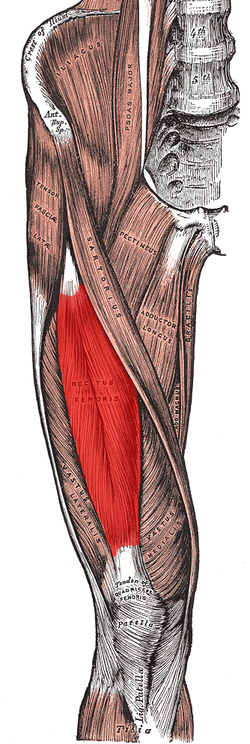Description
Rectus femoris is a bulk of muscle located in the superior, anterior middle compartment of the thigh and is the only muscle in the quadriceps group that crosses the hip[1].
It is superior and overlying of the vastus intermedius muscle and superior-medial part of Vastus lateralis and Vastus medialis.
The word rectus is a latin word connoting “straight”. Thus the rectus femoris received its name because it runs straight down the thigh[2].
It is a two way acting muscle as it crosses over the hip and knee joint; therefore, it contributes to 90° of knee flexion and assists iliopsoas in hip flexion[3][1].
A short rectus femoris may contribute to a higher positioned patella in relation to the contralateral side. A markedly shortened rectus femoris is suggested by knee flexion of less than 80°or by marked prominence of superior patellar groove[4]
Anatomy
Origin
Rectus Femoris originates from anterior inferior iliac spine(AIIS) and the part of alar of ilium superior to the acetabulum[1]
Insertion
Rectus Femoris together with vastus medialis, vastus lateralis and vastus intermedius joins the quadriceps tendon to insert at the patella and tibial tuberosity (via patellar ligament)[4].
Nerve supply
Rectus Femoris is innervated by the femoral nerve, originating from lumbar nerve 2, 3, and 4 nerve roots
Bloody supply
Blood is supplied to the Rectus Femoris via descending branch of the lateral circumflex femoral (LCF) artery.
Function
Hip flexion
Knee extension
- Together with other muscles that are part of the Quadriceps femoris, it facilitates knee extension.
- In terminal swing phase rectus femoris acts as an extensor of the knee, as a muscle in the quadriceps group, it generate force needed for loading(foot flat phase) in stance phase[5].
- Rectus femoris is more efficient in movement combining hip hyper-extension and knee flexion or from a position of knee extension and hip flexion. For example kicking a soccer ball[2][3]
Assessment
Palpation
Rectus femoris can be palpated as it is the most superior of the quadriceps muscles. Start palpation at AIIS, rectus femoris can be felt until its insertion into the quadriceps tendon. Asking the patient to isometrically contract quadriceps will help to identify the muscle belly.
Strength[6]
To assess muscle strength for the Rectus Femoris (including rest of the quadriceps group) position the patient in sitting with the hip and knee flexed to 90° for grade 5, 4 and 3 while grade 2, is assessed in side-lying with test limb uppermost and knee flexed to 90° position.
Other Tests[7]
In Rectus femoris injury :
- FABER (Patrick’s test) – illicit no pain
- Pain is felt in resisted hip flexion[8]


